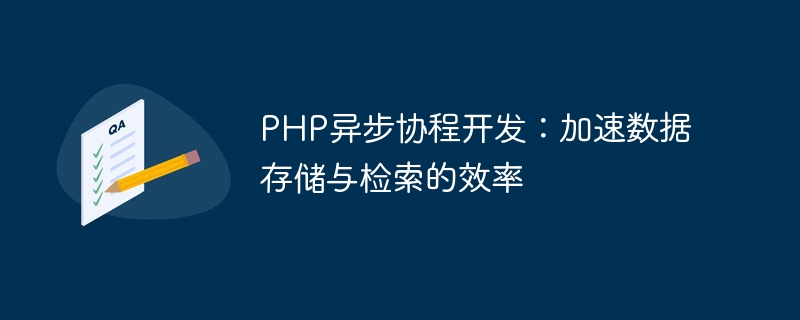

As the scale of Internet applications and the number of users continue to increase, the demand for data storage and retrieval has become increasingly significant. The traditional data storage method uses a single-thread blocking I/O model, which cannot meet the needs of fast storage and retrieval of massive data. The use of asynchronous coroutine development mode can achieve efficient data storage and retrieval, accelerate application response speed, and improve system performance and stability.
PHP is a widely used programming language that has a wide range of application scenarios in web development. PHP 7 adds asynchronous coroutine support in the language, making it easier for PHP developers to use asynchronous programming. The following will introduce the application of PHP asynchronous coroutine development in data storage and retrieval.
1. Asynchronous MySQL client based on Swoole
Swoole is an asynchronous network communication framework based on PHP, with built-in asynchronous TCP/UDP sockets, asynchronous MySQL clients, and pure PHP Features such as coroutines. Developers can use Swoole to easily implement asynchronous programming and reconstruct traditional blocking I/O applications.
The following is a sample code using Swoole asynchronous MySQL client:
<?php
$mysql = new SwooleCoroutineMySQL();
$mysql->connect([
'host' => '127.0.0.1',
'port' => 3306,
'user' => 'root',
'password' => 'xxxxx',
'database' => 'db_name',
]);
// 异步协程执行 MySQL 查询语句
SwooleCoroutineun(function () use ($mysql) {
$result = $mysql->query('SELECT * FROM `table_name` WHERE `id`=?', 123);
var_dump($result);
});
Through the above code, we can easily implement an asynchronous MySQL client based on Swoole and query data in the coroutine.
2. Use Redis queue to achieve high-throughput data storage
Redis is a memory-based KEY-VALUE storage system with the characteristics of high-speed reading and writing and simple data types. In applications, we can use the data structure of Redis to implement efficient task queues. For data storage and retrieval, Redis also has similar functions to MySQL.
The following is a sample code that uses Redis queue to achieve high-throughput data storage:
<?php
// 连接 Redis 数据库
$redis = new Redis();
$redis->connect('127.0.0.1', 6379);
// 将要存储的数据转换成 JSON 格式并推送到 Redis 队列中
$data = ['name' => '张三', 'gender' => '男', 'age' => 18];
$json_data = json_encode($data);
$redis->lpush('data_queue', $json_data);
Through the above code, we can convert the data to be stored into JSON format and push it to the Redis queue. Enable high-throughput data storage.
3. Use Elasticsearch to achieve efficient data retrieval
Elasticsearch is a distributed search engine based on Lucene, with functions such as efficient full-text retrieval and document data analysis. In PHP development, we can use the Elasticsearch client library to achieve efficient data retrieval.
The following is a sample code that uses Elasticsearch to implement data retrieval:
<?php
use ElasticsearchClientBuilder;
// Elasticsearch 配置
$params = [
'hosts' => [
'http://127.0.0.1:9200',
]
];
// 创建 Elasticsearch 客户端
$client = ClientBuilder::create()->setHosts($params['hosts'])->build();
// 搜索名称为“张三”的文档数据
$params = [
'index' => 'my_index',
'type' => 'person',
'body' => [
'query' => [
'match' => [
'name' => '张三',
]
]
]
];
$response = $client->search($params);
Through the above code, we can use Elasticsearch to achieve efficient data retrieval and query the document data named "Zhang San".
In summary, PHP asynchronous coroutine development can achieve efficient data storage and retrieval, improve application response speed and system performance stability. Developers only need to use the corresponding asynchronous framework and client libraries to easily implement asynchronous programming.
The above is the detailed content of PHP asynchronous coroutine development: speed up the efficiency of data storage and retrieval. For more information, please follow other related articles on the PHP Chinese website!